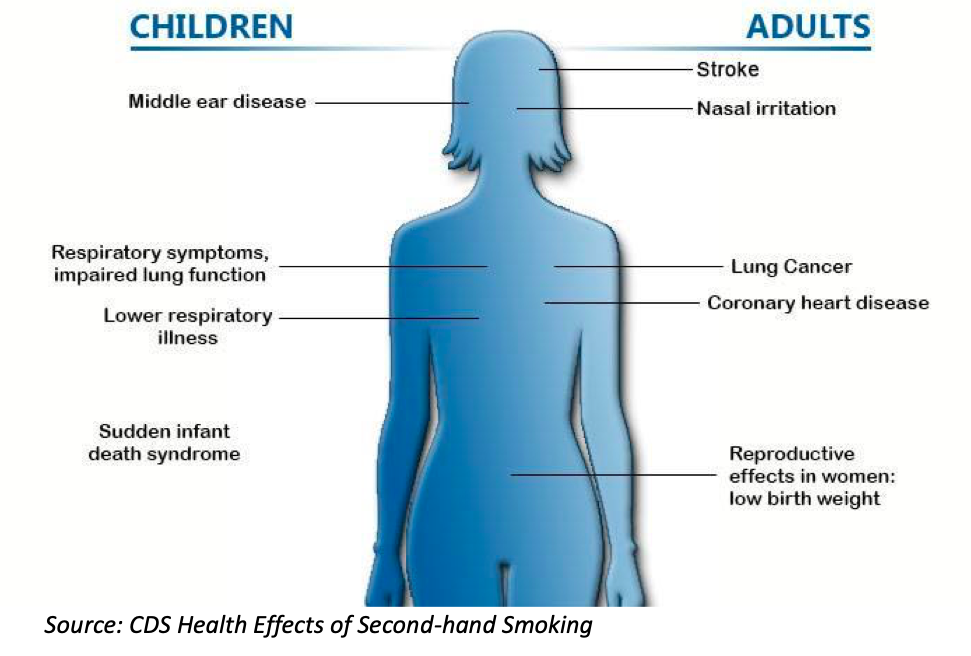It’s no secret that smoking is a significant risk factor causing cancer. Cigarettes, waterpipes and e-cigarettes all increase the cancer burden. When talking with patients who are current smokers aboutcessation possibilities, they often refuse saying that it’s only their health. However, that isn’t necessarily true. Smoking can also affect non-smokers. Second-hand smoking, passive smoking, involuntary smoking – all these terms describe tobacco smoke pollution or environmental tobacco smoke emitted from the burning end of smoked tobacco products. It is proven that inhalation of second-hand smoke by nonsmokers causes premature death and several diseases. So, smoking cessation is not only in the active smoker’s best interest.
Whose choice to inhale smoke?
It is proven that non-smoking adults who immediate harmful effects on their heart disease or stroke in the future. Besides such as asthma, lung cancer is also second-hand smoke contains carcinogens, the combustion of tobacco and are were exposed to second-hand smoke had and blood vessels. It can cause coronary heart coronary heart disease and respiratory issues, associated with second-hand smoking. The which come from exhaled from smokers. Passive smokers inhale carcinogens, such as polycyclic aromatic hydrocarbons, benzene, cadmium, or tobacco-specific nitrosamines, as well as the active smokers. The difference is that second-hand smokers are usually breathing smoke involuntarily. Everybody should be able to control their own health by breathing smoke-free air.
Pregnant women
Pregnant women should avoid the smoke from cigarettes. Smoking mothers-to-be deliver babies, who on average weigh about 150–250 grams less than non-smokers’ newborns.
Children exposed to second-hand smoke in the home are particularly vulnerable.
The infants of parents who smoke at home aren’t able to avoid second-hand smoke. It was reported that children exposed to second-hand smoke are at the higher risk for Sudden Infant Death Syndrome (SIDS). According to one US study, the lungs of infants who die from SIDS show higher concentrations of both nicotine and cotinine. Cotinine is a biological marker forsecondhand smoke exposure and metabolize similar chemicals and hydrocarbons, benzene, cadmium, or tobacco-specific nitrosamines, as well as the active smokers. The difference is that second-hand smokers are usually breathing smoke involuntarily. Everybody should be able to control their own health by breathing smoke-free air.
Studies have shown that children exposed to second-hand smoke grow up with weaker lungs, they are sick more often, and respiratory difficulties; wheezing, coughing and shortness of breath are more prevalent. They are also more vulnerable to ear infections as well as severe asthma attacks, which can put their life in danger.

As you can see from this diagram above, second-hand smoking has significant effects on our health. So, what can we do to avoid second-hand smoke?
- Do not allow anybody to smoke in or near your home - it can be helpful to explain the reasons why
- Do not allow anybody to smoke in your car. Having the window down doesn’t reduce your exposure and is
not the solution - again, it can be helpful to explain the reasons why - Speak up if you are exposed to second-hand smoke at your workplace, talk with your smoking colleagues
about your concerns - If your country or state still allows smoking in public areas, avoid restaurants and other places which are not
tobacco-free. “No-smoking” sections aren’t an effective solution to protect you and your family - Be the role model - show your kids that cigarettes aren’t part of your life, speak with them about the risks of
tobacco products, create a #TobaccoFreeGeneration - If you are a smoker, be a role model of positive change. Find out about your cessation possibilities
- As a nurse, don’t forget to ask your patients about second-hand smoking. Encourage them to avoid it if possible.
Quitting tobacco products yourself is never easy, but showing the healthier way to others can be even more difficult. Show patience and speak with smokers about their possibilities; give them support, help them believe that they can quit. Let’s help them to become healthier without tobacco smoke. Let’s do it for them as well as for ourselves.
Find out more and download the PrEvCan resources on second-hand smoking.
References:
[1] European Code Against Cancer - Why should non-smokers breathing other people’s smoke be concerned aboutdeveloping lung cancer? (iarc.fr)
[2] Health Effects of Secondhand Smoke | CDC
[3] U.S. Department of Health and Human Services. The Health Consequences of Smoking—50 Years ofProgress: A Report of the Surgeon General. Atlanta: U.S. Department of Health and Human Services, Centers for Disease Control and Prevention, National Center for Chronic Disease Prevention and Health Promotion, Office on Smoking and Health, 2014
[4] U.S. Department of Health and Human Services. The Health Consequences of Involuntary Exposure to Tobacco Smoke: A Report of the Surgeon General. Atlanta: U.S. Department of Health and Human Services, Centers for Disease Control and Prevention, National Center for Chronic Disease Prevention and Health Promotion, Office on Smoking and Health, 2006
[5] Institute of Medicine Committee on Secondhand Smoke Exposure and Acute Coronary Events. Secondhand Smoke Exposure and Cardiovascular Effects: Making Sense of the Evidence. Washington, D.C., National